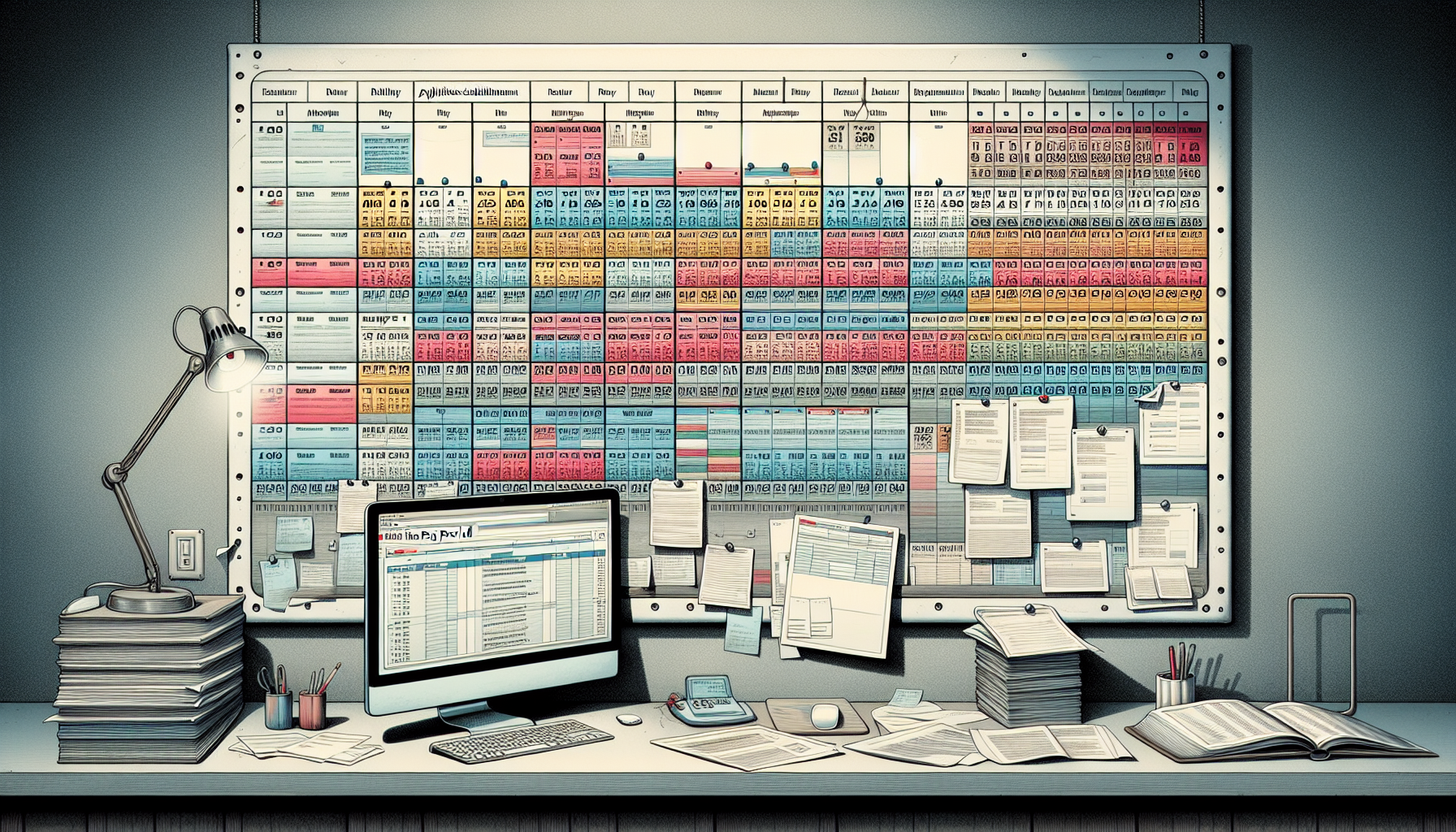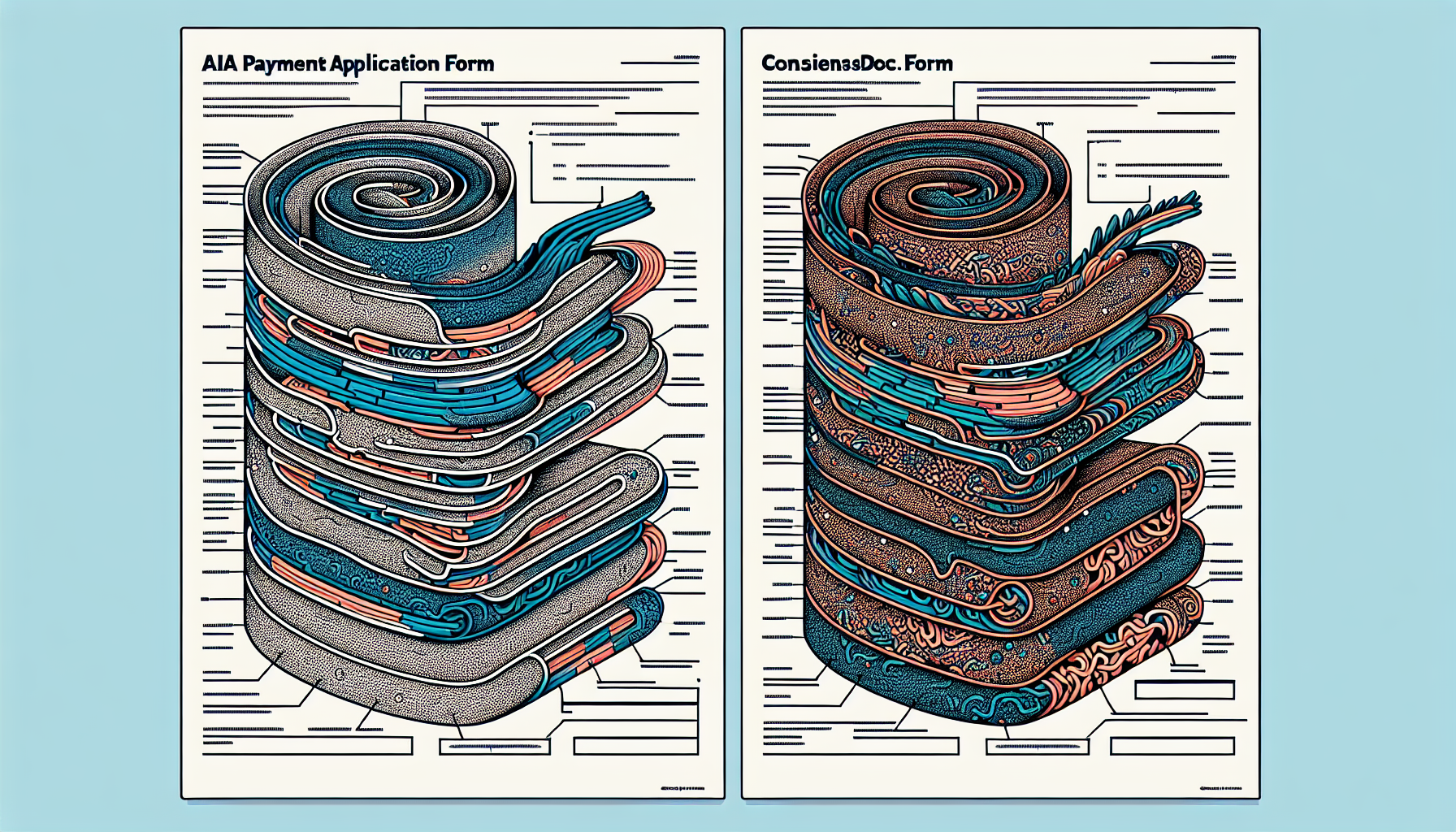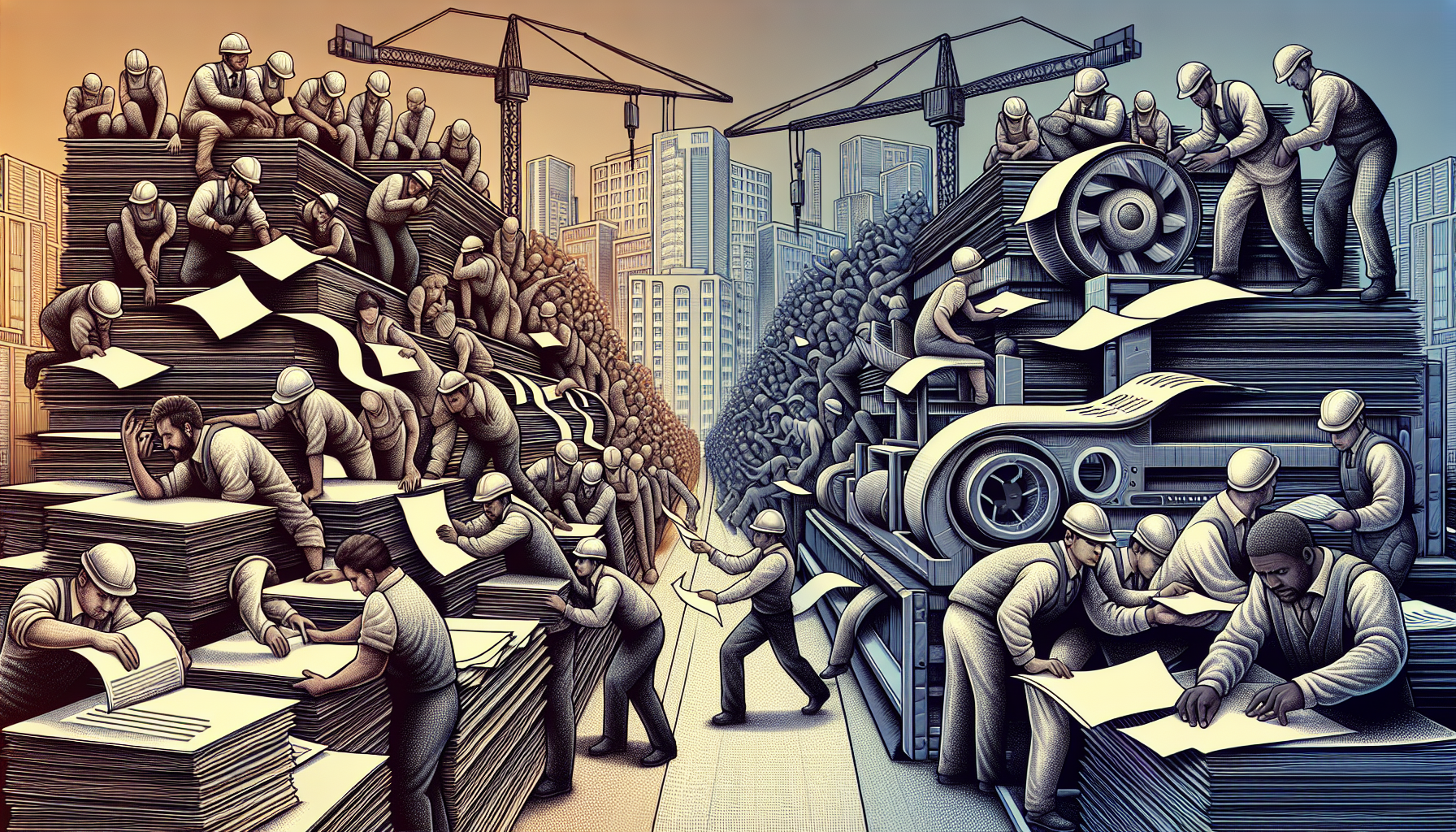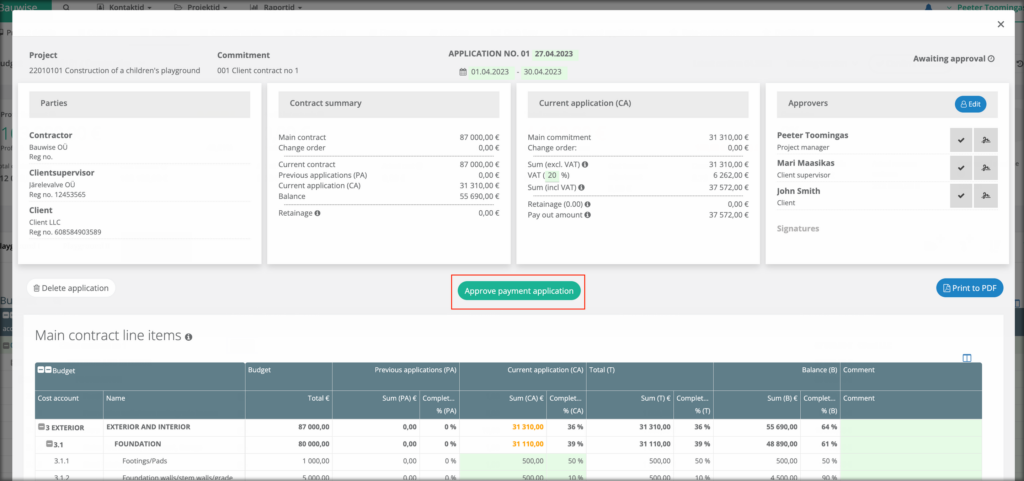A construction pay application is more than a bill—it’s a financial lifeline that keeps a project on track. Contractors and subcontractors rely on these detailed documents to verify work and secure payment. Our guide cuts through complexity, offering clear steps to create, submit, and ensure the approval of your construction pay applications effectively.
Table of Contents
1. Key Takeaways
Pay applications in construction facilitate cash flow by providing detailed accounts of project progress, materials used, and labor to all stakeholders, requiring meticulous documentation to ensure payment accuracy and maintain momentum.
A comprehensive payment application includes a pay application form, schedule of values, lean waivers, and supplemental proof of work materials, which are essential in fostering a culture of fair play and ensuring timely remuneration for the work completed.
The submission of pay applications must adhere to contractual timelines and best practices, with a streamlined process and strong stakeholder relationships being key to efficient financial management and avoidance of payment delays.
2. Deciphering the Pay Application in Construction

In the realm of construction, pay applications are not just requests for payment; they are the narrators of the project’s financial story. They provide a detailed account of the progress made, materials used, and the labor expended. Pay applications, often referred to as pay apps, are the lifeblood of cash flow for construction projects. They ensure that all parties involved—from the steel-toed boots on the ground to the paper-pushers in the office—are compensated for their contributions to erecting structures that stand the test of time.
A portion of the payment, known as ‘retainage,’ is withheld until the project is completed to ensure all work is satisfactorily finished.
The pay application form is a carefully crafted dossier, distinct from a standard invoice, that captures the complexity of construction deliverables. It is a compilation of supporting documents that furnish proof of work done and materials provided, safeguarding the interests of contractors and offering validation for the funds requested. The precision of these documents is not just about getting paid; it’s about building trust through transparency and ensuring that the financial narrative of the construction job is an open book for all stakeholders involved.
Navigating the submission of a pay application is akin to plotting a course through a financial labyrinth. It demands adherence to the construction contract’s terms and an understanding of the payment application process that governs the flow of funds. The stakes are high; a well-submitted pay application can mean the difference between keeping the gears turning on a construction site or grinding them to a halt due to stalled payments. Thus, mastering the pay application can be seen as mastering the art of maintaining momentum in the construction industry.
The Role of Pay Apps in Progress Billing
Progress billing in the construction industry is not a mere transfer of funds; it’s a sign of progress, a nod to the hard work that has transformed blueprints into tangible structures. Pay apps are the messengers in this process. They are the financial snapshots that capture the state of play, determining the amount that contractors and subcontractors should be compensated for during a designated billing period.
Each pay app tells a story of progress, including the twists of retainage—a portion of payment kept on hold until the project’s completion. This cautious approach to payment is a safeguard, ensuring that the total value of work done is recognized and compensated, fostering a culture of fair play and timely remuneration throughout the project’s lifecycle. By using a pay app, contractors can efficiently receive payment without any unnecessary delays.
Crafting a Compliant Pay Application Form
The architecture of a compliant pay application form includes:
Project name, dates, and contact information
Comprehensive financial breakdown, including change order details
Schedule of Values (SOV), itemizing the project’s workload and associated costs
Change orders
This structure ensures a transparent progress billing.
Customization is key; the pay app must mirror the unique demands of the project, following the billing method and owner’s specific requirements. Change orders, those inevitable deviations from the original plan, find their rightful place in the pay application, ensuring every twist and turn of the project is financially accounted for. And while Excel templates might lend a hand in ensuring industry standards are met, notarization—though not always mandatory—can add a layer of authenticity that accelerates the payment process.
A compliant pay application form is not just a document; it’s a declaration of work completed, a promise of quality upheld. It stands as a testament to the contractor’s dedication, bridging the gap between the work done and the payment due, ensuring every nail hammered and every brick laid is recognized in the grand financial scheme of the construction project.
Ensuring Accurate Payment Applications
Accuracy in payment applications is the golden rule for contractors aiming to get paid faster. It is the precision of documentation that speaks volumes, echoing the legitimacy of the work completed. Subcontractors, in particular, find solace in the details, knowing that their thoroughness is their best advocate in requesting payment.
Adherence to the unique requirements of the contract is paramount; it is the compass that guides contractors through the payment application process, ensuring that every ‘i’ is dotted and every ‘t’ is crossed. Communication is the bridge that connects the dots, especially when project owners revise payment rules. Providing the necessary supporting documentation is not just a chore; it is a crucial element of efficiency, a practice that smoothens the course and leads to the ultimate goal—payment.
3. Anatomy of a Comprehensive Payment Application

A comprehensive payment application is like a robust scaffold supporting a structure; it must be built with the strongest materials and precise engineering. At its core, a payment application is a collection of detailed documents that serve as a progress report on the project, proving the completion of work and installation of materials. It is the meticulous documentation within these applications that can become a Herculean task, especially for smaller construction companies grappling with the extensive pages required to paint a full financial picture.
A continuation sheet details the work accomplished and its associated value, supporting the main pay application form.
The anatomy of a pay application is complex, comprising essential documents that tell the story of the project’s evolution. These documents, ranging from the pay application form itself to supplemental papers, combine to form a narrative that conveys the total value of the work completed to date. It is not just a collection of papers; it’s a curated exhibit of the project’s financial journey, a journey that is crucial to the survival of the parties involved in the construction process.
The pay app is:
the puzzle that, when pieced together correctly, showcases the effort, time, and resources invested in a construction project
the bridge between the work done and the payment to be received
a bridge that must be crossed with diligence and thoroughness to ensure that the financial flow of the project remains unimpeded.
Essential Documents for a Complete Pay App
The backbone of a complete pay app is its documentation, starting with the Application for Payment Form and supported by a Continuation Sheet. It starts with the Application for Payment Form, a document that initiates the payment process, and is supported by a Continuation Sheet, detailing the work accomplished and its associated value. Just as a building relies on its foundation, a pay application relies on these essential documents to stand firm in its request for payment.
The supporting cast of documents—photos, invoices, receipts—provides the evidence needed to validate the pay application, much like eyewitnesses in a trial. Payroll reports and prevailing wage reports are the financial ledgers of the labor force, essential for demonstrating labor expenses to the general contractor. It is these documents that substantiate the request, ensuring that every penny is accounted for, every material traced back to its source.
The Schedule of Values (SOV) must be in harmony with the pay period deadlines, presenting a clear picture of the work completed and materials purchased during the time frame covered by the pay app. Additional documents, such as insurance and bonding papers, might be required to strengthen the application further, depending on the project’s scope. It’s a symphony of paperwork that, when played correctly, results in the sweet sound of payment.
Importance of Lien Waivers
Lien waivers are not just documents; they are shields that protect the payor from future financial claims on the property. They are a key component of the pay application, serving as an acknowledgement that the contractor has been paid and waiving their right to place a lien on the property for the billed amount.
The construction industry operates with two main types of lien waivers: conditional and unconditional. Conditional lien waivers come into effect once payment conditions are met, while unconditional waivers immediately waive lien rights, regardless of payment status. Most general contractors require these waivers as part of the payment application, not only to mitigate the risk of property liens but also as a means to expedite the payment process.
Additional Proof: Backing Up Your Pay Application
Beyond the required forms and waivers, additional proof serves as the bedrock of a solid pay application. Daily reports, capturing the hustle and bustle of the construction site, become part of the pay app dossier, offering a record of ongoing progress. Site visits from owners and architects may follow, their scrutinizing eyes verifying that the billed work aligns with the reality on the ground.
Prevailing wage reports, especially for government projects, certify that laborers are paid their due, adding another layer of credibility to the payment application. These documents are not mere formalities; they are the pillars that uphold the integrity of the pay application, ensuring that the financial narrative is accurate and the payment justified. Providing detailed and comprehensive documentation is akin to laying a strong foundation; it increases the likelihood of approval and timely payment, ultimately contributing to the project’s financial health.
4. Timelines and Best Practices for Submitting Pay Applications

Navigating the timelines and best practices for submitting pay applications is like charting a course through the ebbs and flows of a project’s financial tide. The cadence of submitting pay applications is synchronized with the contractual draw schedule, with some contractors choosing monthly intervals, others upon the completion of project stages, or after achieving specified percentages of work completion. The industry cadence, however, typically beats to the monthly drum, with contractors and subcontractors aligning their submissions to an agreed-upon date each month.
Missing the beat by failing to meet contractual application submission deadlines or omitting necessary information can lead to significant payment delays—a nightmare scenario for any construction project. Adhering to the established timelines is not just a best practice; it’s a lifeline for ensuring the financial pulse of the project remains steady and strong.
It’s a dance where timing is everything. Submitting pay applications on schedule not only reflects professionalism but also reinforces the trust between contractors and project owners. It’s a trust that, once established, can lead to smoother payments and a project that marches to the beat of progress without missing a step.
Aligning with Pay Period Schedules
The cadence of submitting pay applications is synchronized with the contractual draw schedule, typically resulting in monthly billing cycles. This alignment ensures that the financial needs of a project are met systematically, without causing undue stress on the project’s cash flow. Contractors, especially, must be acutely aware of this synchronization, as it underpins their ability to maintain a healthy cash flow and fulfill financial commitments to subcontractors.
By aligning with pay period schedules, contractors can effectively manage expectations and financial planning. It allows for a predictable and steady flow of funds, which is vital for keeping the project wheels turning. After all, the rhythm of payments must match the rhythm of work for a construction project to flourish.
Streamlining the Pay Application Process
Streamlining the pay application process is about more than just dotting i’s and crossing t’s; it’s about creating a seamless flow of documentation and communication that leads to timely payments. Consistent documentation, as required by general contractors, is the first step in this process—a step that ensures accurate tracking and processing of payment applications.
But the path to efficiency doesn’t stop there. General contractors need to clearly communicate their payment schedules, aligning them with project owners and ensuring they trickle down to subcontractors. Finding the right balance of detail is crucial, including sufficient information to secure payment without overburdening the application with unnecessary data that could set cumbersome precedents for future applications.
5. Navigating Payment Application Forms: AIA vs. ConsensusDocs

In the construction industry’s financial orchestra, two primary scores can be played: the AIA G702 Application and Certificate for Payment, and the ConsensusDocs 292 Pay App. These forms are the linchpins of the payment application process, each with its own cadence and nuances. The AIA documents, with a century of legal interpretations under their belt, have become a familiar tune for many, although they’ve faced critiques for being architect-biased, which may not always harmonize with the needs of owners or contractors.
ConsensusDocs, on the other hand, are the result of a collaboration among more than 40 industry associations, offering a composition that resonates with a broad sector of the construction industry. Understanding the endorsements and legal background of these two forms is crucial for contractors. It guides them in choosing the score that best fits their project’s needs and minimizes the potential for discord.
Selecting the right form is akin to choosing the right instrument for a musical piece—it must be in tune with the project’s needs and complexity. AIA and ConsensusDocs each offer a distinct melody, and it is up to the contractor to conduct the one that will result in the most harmonious outcome.
Choosing the Right Form for Your Project
Choosing the right pay application form for a construction project is akin to selecting the proper materials for a building; the choice can have a significant impact on the project’s success. The complexity and scale of the project should guide the decision, as larger, more intricate projects may necessitate a more detailed pay application form. Familiarity with the chosen form can streamline the application process, ensuring time is not lost to unnecessary errors and misinterpretations.
Contractors often have preferences based on their past experiences, which can influence their choice of pay application forms. While large-scale projects might require extensive documentation provided by the likes of AIA documents, smaller jobs could benefit from the simplicity and directness of ConsensusDocs. Ultimately, the aim is to ensure accurate financial reporting and maintain clarity throughout the payment process, making the choice of form a critical decision in the construction project’s financial management.
Customizing Forms to Fit Contractual Needs
Every construction project is unique, and the pay application forms should reflect the project’s specific needs and conditions. Customizing these forms is not just a matter of preference; it’s a negotiation process that aligns the documents with the contractual demands of the project. By tailoring the forms, contractors can ensure that the pay application speaks directly to the nuances of the project, satisfying the requirements of all stakeholders involved.
The negotiation of pay application requirements is a strategic process. It’s an opportunity for contractors to assert their expertise and secure terms that are favorable to their financial health. From addressing the project’s scope to discussing the number of revisions, every detail in the contract can be a point of negotiation, ultimately leading to a pay application form that serves the best interests of the contractor and the project.
6. Challenges and Solutions in Construction Payment Applications

The journey of a construction payment application is fraught with challenges that require navigation with skill and foresight. One such challenge is the role of the construction lender, who dictates the formal payment exchange process and can significantly impact the project’s financial flow. The lender’s influence underscores the importance of understanding and adhering to the payment application guidelines set forth by the financial institutions involved.
Addressing Frequent Pay Application Pitfalls
In the bustling world of construction, pay application pitfalls are like hidden obstacles that can trip up even the most experienced contractors. Mismanaged pay applications can cascade into financial turmoil and project delays, with nonpayment straining the cash flow of lower-tier contractors, and the lack of correct lien waivers leading to payment bottlenecks. Effective communication, therefore, becomes the antidote to these pitfalls, preempting misunderstandings and ensuring a smooth payment flow that keeps the project within budget and on schedule.
Subcontractors, in their quest for payment security, employ risk management strategies that include providing comprehensive documentation such as receipts from laborers and suppliers to solidify their pay applications. On the other hand, general contractors must manage progress payments adeptly, sometimes requesting payment for materials not yet installed if the contract allows, while also dealing with the financial strain of retainage that is only released upon substantial completion of the project. All these challenges highlight the importance of including documented proof of work in the pay application, fostering a transparent and dispute-free payment process.
Building Strong Relationships with Stakeholders
Constructing a sturdy building requires a solid foundation, just as building a robust payment application process necessitates strong relationships with stakeholders. Trustworthiness and open communication are the cornerstones of these relationships, streamlining the submission and approval of construction pay applications. By engaging in proactive dialogue and adapting to changing requirements, contractors ensure that their pay applications align with stakeholders’ updated expectations.
Identifying the different stakeholder categories and understanding their specific needs is crucial for crafting pay application requirements that meet everyone’s expectations. Clarity in communication and investment in understanding the stakeholders’ perspectives can mitigate misalignments in urgency and adherence to project timelines.
Some key stakeholder categories to consider are:
General contractors
Subcontractors
Suppliers
Owners
Architects/engineers
Lenders
Specialty contractors, who often sit further down the payment chain, must be judicious in their contract choices to protect their interests in the final payment amounts.
Tools like ConsensusDocs contracts, which encourage direct communication to resolve issues, play a significant role in promoting timely project completion and the resolution of pay application disputes.
7. Leveraging Technology for Efficient Payment Applications
The advent of technology has revolutionized the construction payment application process. Modern construction payment application software solutions provide the tools to manage and track pay applications with greater efficiency, akin to upgrading from manual tools to power tools on a construction site.
Solutions like Siteline offer benefits such as automating the pay application process and contributing to the maintenance of healthy business finances.
Solutions like Siteline offer the following benefits:
Automate the pay application process
Contribute to the maintenance of healthy business finances
Allow for a more streamlined approach to financial management.
Automated Systems for General Contractors and Subcontractors
In the fast-paced world of construction, some useful automated tools include:
Automated pay app systems, which help general contractors and subcontractors save time, manage payments, and reduce disputes
Task management software, which consolidates tasks into a single platform, enhancing efficiency
Punch list apps, which help resolve items quickly, contributing to a smoother project close-out phase
Stakeholder management tools like Wrike, which increase project visibility and status updates, fostering trust and improving communication across the board.
These tools can greatly improve productivity and streamline processes in the construction industry.
These automated systems facilitate the preparation of compliant pay application forms, leading to faster payment processing and saving precious time. Moreover, integration with construction accounting systems streamlines the payment process, demonstrating how harnessing technology can lead to significant gains in efficiency and financial oversight.
Real-Time Tracking for Financial Oversight
The introduction of real-time tracking in payment application software has been a game-changer for financial oversight in the construction industry. Real-time dashboards provide an immediate overview of financial operations and pay application progress, allowing construction professionals to:
Make informed decisions swiftly
Enhance the management of financial data
Streamline the pay application process
Make it more manageable
When integrated with ERP systems, software like GCPay enhances the management of financial data, streamlining the pay application process and making it more manageable.
Custom reporting and dashboard features enable users to manage payment documentation easily and view key financial metrics, ensuring that the financial health of the project is constantly monitored. With the help of real-time tracking and integrated software features, companies can achieve more effective financial oversight, positively influencing their cash flow and ensuring the project’s financial success.
8. Construction Payment Application Template
Download Free construction payment application templates:
9. Summary
In conclusion, mastering construction pay applications is essential for ensuring streamlined payments and maintaining the financial health of construction projects. From the detailed documentation included in a pay app to the strategic timing of submissions, every aspect plays a crucial role in the successful financial management of a construction project. Contractors must navigate the complexities of pay applications with precision, negotiating terms when necessary, and leveraging technology to enhance efficiency.
Remember, the construction pay application is more than just a means to an end—it’s a crucial process that supports the financial backbone of the industry. By understanding and adhering to the best practices laid out in this guide, contractors can ensure that their financial narrative is clear, their relationships with stakeholders are strong, and their payment processes are efficient. With this knowledge, the path to financial success in construction becomes clear.
10. Frequently Asked Questions
What is a pay application in construction?
A pay application in construction is the financial heartbeat of a project, a comprehensive set of documents that contractors submit to request payment for work completed or materials provided. This thorough request for payment delves deeper than a simple invoice, substantiating the complexities of construction deliverables with detailed schedules, reports, and supporting materials to confirm progress and delivery.
What’s included in a pay application?
A pay application is a multifaceted document that includes:
The pay application form
A schedule of values
Change orders
Conditional lien waivers
A host of visual documentation and receipts
It reflects the guidelines outlined in the construction contract, displaying a breakdown of the work completed and the payment due, and often contains proof of completed work or materials stored.
This collection of documents is fundamental to the transparency and accountability of the financial aspects of a construction project.
When does a contractor send a pay application?
Contractors send pay applications at regular intervals, as defined by the payment schedule of the construction contract. These intervals may be linked to the completion of specific project milestones or set at regular timeframes, such as monthly. Contractors must ensure that their payment schedules are in sync with subcontractors and project owners to manage cash flow effectively and maintain the financial rhythm of the project.
Who approves payment applications in construction?
The approval of a payment application in the construction world is a multi-stakeholder affair. It typically involves the owner, construction manager, lender, or investors, depending on the contractual agreement. Project owners have the responsibility to approve or disapprove invoices within a defined timeframe, with specific reasons required for any disapproval. If the owner fails to make timely payments, they may incur interest charges, and contractors may suspend performance if payment deadlines are not met.
Upon substantial completion, contractors can submit a final invoice, marking a significant milestone in the project’s financial timeline.
Can contractors negotiate pay application requirements?
Contractors, wielding the tools of experience and expertise, have the flexibility to negotiate the terms of their pay applications. This negotiation can cover payment amounts, terms, and even the structure of the pay application itself. By establishing a minimum acceptable rate, building strong client relationships, and proposing fixed rates or higher initial offers, contractors can enhance their negotiating position.
What is the difference between a payment application and an invoice?
The difference between a payment application and an invoice in the construction industry is a matter of complexity and detail. While an invoice is a straightforward request for payment for services or goods delivered, a payment application is a detailed and substantiated request that often includes a collection of documents such as schedules, reports, and lien waivers.
A payment application provides a comprehensive breakdown of the construction work completed, while an invoice focuses on single transactions or professional services without needing such an extensive record.
What is the difference between a conditional and an unconditional lien waiver?
The main difference between a conditional and an unconditional lien waiver is that a conditional lien waiver becomes effective upon meeting payment conditions, whereas an unconditional lien waiver immediately waives liens regardless of payment status. It’s important to understand these differences when dealing with lien waivers.
Can the lack of correct lien waivers lead to payment delays?
Yes, incorrect lien waivers can lead to payment delays as they are necessary to mitigate the risk of property liens.
Why is accurate financial reporting crucial in pay applications?
Accurate financial reporting is crucial in pay applications to ensure clear financial breakdowns and maintain clarity throughout the payment process, which is essential for the financial management of the project. This helps to avoid misunderstandings and disputes.
How can technology improve the pay application process?
By automating payment management, providing real-time tracking, and integrating with accounting systems, technology improves the pay application process, saving time and enhancing efficiency.
Why are pay applications important in construction?
Pay applications are a cornerstone of the financial management of construction projects. They provide a detailed request for payment, incorporating risk management strategies and acting as progress reports to ensure that contractors meet project milestones and maintain adherence to quality and schedule. These applications are essential for facilitating regular progress payments, tracking and reporting expenses, and ensuring timely payments to contractors and subcontractors.
Additionally, they include the collection of essential documents, such as lien waivers, which enhance transparency between stakeholders and maintain clear property titles.
About the Author

Taavi Kaiv
Taavi Kaiv is a construction specialist with over ten years of experience in the construction industry. Taavi is an accomplished construction project manager with many successful projects that have been completed under his guidance. Taavi holds a master’s degree in construction management from the Tallinn University of Technology. View profile






